NVIDIA’s GeForce GTS 450: Pushing Fermi In To The Mainstream
by Ryan Smith on September 13, 2010 12:02 AM EST- Posted in
- NVIDIA
- Fermi
- GeForce GTS 450
- GF106
- GPUs
Overclocking
As we alluded to in the opening of this article, NVIDIA is once again pushing the overclockability of their GPUs. The GF106 GPU at the heart of the GTS 450 is supposed to be about as overclockable as the GF104 GPU instead the GTX 460, and there’s little doubt that this is the case. NVIDIA’s partners are already on the bandwagon, and are offering heavily overclocked cards. Or for the do-it-yourself types, even the average reference card should be quite overclockable as long as you’re willing to take the risk of the periodic dud.
The GTS 450 is already supported by the latest version of MSI’s excellent afterburner software, and keeping with their policy MSI has enabled overvoltage support for all cards using the same VRMs as the reference card. So we were able to overvolt all of our reference cards and our factory overclocked cards. The VRMs on all of the cards except the Asus card top out at 1.162v, however for safety reasons (and the fact that the VRMs aren’t even passively cooled) we limited ourselves to 1.15v.
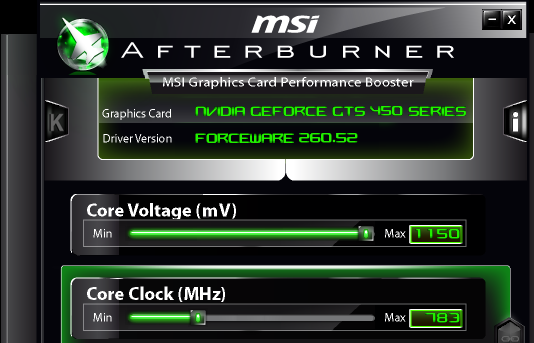
As not all of our cards are exactly alike, we’ll quickly run down the differences between the various cards
- 2x NVIDIA GTS 450 Reference
- 1x Calibre X450G. Reference PCB, aftermarker cooler, factory overclocked
- 1x EVGA GTS 450 FTW. Reference PCB, reference cooler, factory overclocked
- 1x Asus ENGTS450 TOP. Reference-derived PCB, custom cooler, factory overclocked
- 1x Palit GeForce GTS 450 Sonic Platinum. Custom PCB, custom cooler, factory overclocked
| Overclocking Results | ||||||
| Stock Clock | Max Overclock | Stock Voltage | Overclocked Voltage | |||
| GTS 450 Reference #1 | 783MHz | 955MHz | 1.05v | 1.115v | ||
| GTS 450 Reference #2 | 783MHz | 930MHz | 1.062v | 1.115v | ||
| Asus ENGTS450 Top | 925MHz | 985MHz | 1.125v | 1.115v | ||
| EVGA GTS 450 FTW | 920MHz | 955MHz | 1.112v | 1.115v | ||
| Palit GTS 450 Sonic Platinum | 930MHz | 985MHz | 1.087v | 1.115v | ||
| Sparkle Calibre X450G | 850MHz | 935MHz | 1.087v | 1.115v | ||
Unlike the GTX 460 launch where the vendor cards we had all came with a mild factory overclock, for the GTS 450 launch all of our cards have a significant factory overclock. 3 of the 4 are at 920MHz or better, which is a 137MHz (17%) overclock over reference speeds.
Even with voltage tweaking capabilities there was a very noticeable range in the overclockability of our cards. The worst card was one of the reference cards, which only hit 930MHz even at 1.15v. The best cards were the Asus and Palit cards at 985MHz. This puts the average overclock at just over 955MHz, which isn’t too far off from the factory overclocks already on some of these cards.
Meanwhile 4.2GHz seems to be the wall for memory overclocking. The GTS 450 is only equipped with 4GHZ GDDR5, so this may not be a fantastic outcome but it is realistic.

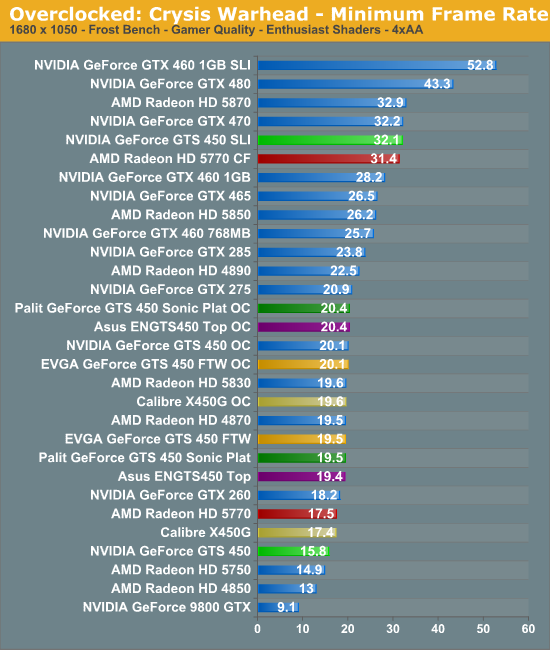
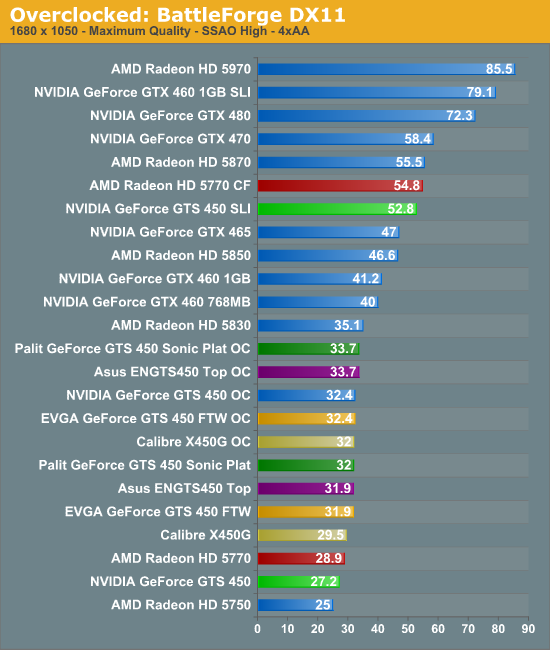
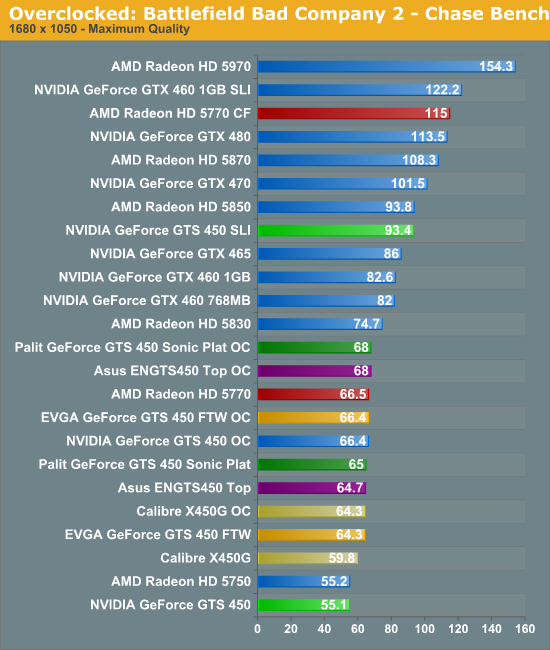
Because our maximum overclocks weren’t too much higher than the factory overclocks on some of these cards, there aren’t many surprises to be had when it comes to overclocking. With a solid overclock you can beat the 5770 most of the time, but it’s not enough to get much higher than that.
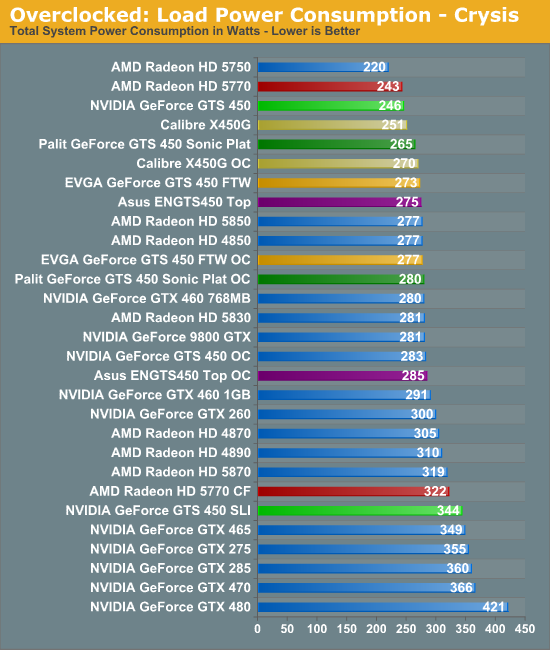
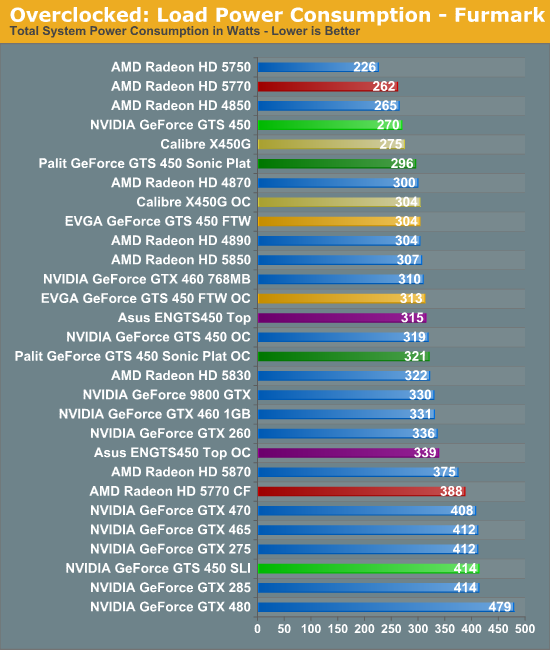

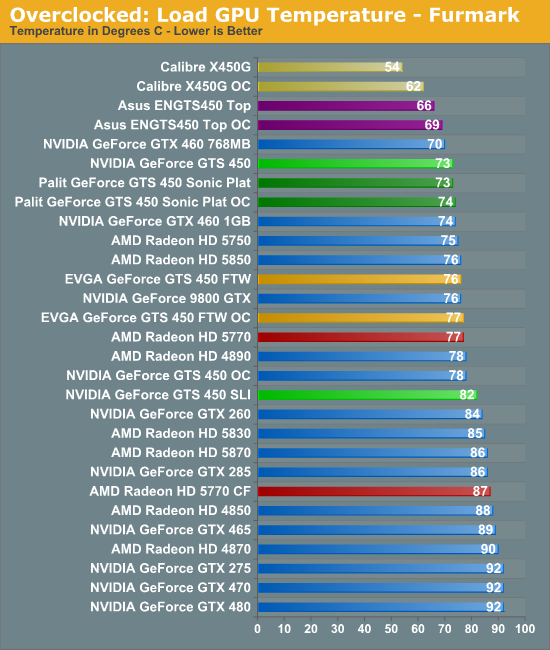

Overclocking (or rather overvolting) has the usual outcome when we look at power, temperature, and noise. The extra power enables extra performance, but it completely blows the performance-per-watt of the GTS 450 cards. Temperature and noise levels rise, but both are actually still quite manageable even at 1.15v. The only things holding the GPU back are the VRMs feeding it, and the innate limits of what the GPU can reach. Given this, it makes little sense not to overclock as long as you have a card with a suitable limit.
Finally, as a testament to how poorly a pair of GTS 450s in SLI get along with each other when they’re right next to each other, we weren’t able to get away with overvolting them at all. Even at 1.1v, the covered card would ultimately reach a thermal runaway under FurMark – the fan would max out and the temperature would start climbing in to the 90s. This shouldn’t be an issue with cards that are separated, but overclocking is definitely not on the menu when they’re packed together.










66 Comments
View All Comments
Ryan Smith - Monday, September 13, 2010 - link
If I had my way, we'd have every card known to man on our charts. But if I had my way, days would be 50 hours long to accommodate all of that testing...In any case not having a GTS 250 is not an oversight on our part - we simply do not have a GTS 250 to test with.
Stuka87 - Monday, September 13, 2010 - link
So it seems to me like the 450 is trying to match performance with the now year old 5770. I really think nVidia should have one upped the competition, like they did with the 460 release.I just can't see this card getting the life that nVidia needs to get out of it. AMD will do a refresh long before nVidia does, which will ultimately mean the 450 will have a very short life in comparison to the 5770.
HangFire - Monday, September 13, 2010 - link
This comment is right on the mark, and part of a disturbing trend I see with new video card generations in general and Nvidia in particular. With each new generation we are getting the same performance, more or less, at the same price points, the only difference is a newer Direct X level, lower power, or less noise, or a new video connector, etc.If all you care about is getting a certain FPS in a few games on one monitor with a certain level of AA and eye candy, the older generation cards would often be a better choice, if they were only available. Unlike in previous generations, which seemed to stay in production forever even when obsolete, the best values either go away (like the 4770 or GTX 275), get recycled at the same or higher price point (8800/9800), or get replaced by similar performance at that price point (GTS 450 vs 250).
The end result is that for a give price point, you are not buying any more Frames per Second then you were 2 years ago- unless you paid too much and made a really bad choice 2 years ago.
While at first I was thrilled to see so many older cards in this review, the GTS 250 is conspicuously absent, perhaps because it is rather embarrassing to see what little new the 450 has to offer in terms of price/performance. The 450 is not yet on Bench either, though I hope that will be remedied soon.
So, congratulations Nvidia, you now have a more complete DirectX 11 lineup, but you've offered me nothing in price/performance to make me want to replace any of my DirectX 10 cards.
just4U - Monday, September 13, 2010 - link
I disagree. Annand put up numbers for the 4850 which has always pretty much walked allover the GTX250 (9800GTX 8800GTX etc) Looking at the graphs the 450 is somewhat faster so including the 250 benchmarks is not neccessary.Also, Both Ati and Nvidia seem to be in a holding pattern as far as performance goes with their current lineups. People upgrading from the latest and greatest from the last generation of video cards won't notice huge gains performance wise. What they will notice (depending on the card) is lower temperatures, less power consumption, and ofcourse more features.
Those upgrading from cards 2+ years old or value oriented cards from the last generation are likely to see the most gains overall with these new ones. The rest of us get a sideways upgrade at best. Atleast thats my opinion anyway.
geniekid - Monday, September 13, 2010 - link
I must also disagree, respectfully. A couple of the benchmarks here show that for less than half the price I paid for my top-of-the-line factory OCed 9800GTX several years ago, I can get about the same or slightly better performance. This shows me that progress is being made - or, at the very least, that price/performance is improving over time.HangFire - Monday, September 13, 2010 - link
Wow, thanks for the respect in the disagreement! But then, this is AT not Tom's.Speaking of Tom's, I just read their GTS450 review, and their statement after the DX9-10 benchmarks (CoD:MW2 and Crysis) mirrors mine vis-a-vis the GTS 250- "Naturally, numbers like this don’t compel you to upgrade." While another site quoted 20-25% better performance, Tom's had the 250 faster than the 450.
I would expect a three generation old top-of-the-line card to have poor value compared to a mainstream card of today. (I say three because a 9800 GTX OC is essentially an 8800 Ultra). Nvidia complicates the issue with generational recycling and the missing GTX 3xx DirectX 10.1 cards that never existed. I'm trying to compare like-to-like, that is mainstream cards in the $140 to $150 range (price at introduction).
If you look at the incremental performance differences of the mid-stream cards 8800GT->9800GT->GTS 250->GTS 450, anyone that actually bought each of these cards for $130->$150 expecting a big generational performance boost with each jump was sorely disappointed. On the AMD side things are a little better, but the mainstream level 4xxx to 5xxx jump was more about power and Eyefinity than performance. (Of course their top-end cards made big jumps, at big $$$).
The new GTS 450 is launched at the same price point the GTS 250 had, and offers very similar performance. Of course, the 250 dropped in price like a stone, because it had to, and the 450 may have some adjustments ahead of it. But let's say it was 25% faster across the board, is it compelling? The 7800GT to 8800GT upgrade, now that was compelling.
just4U - Monday, September 13, 2010 - link
You have to remember something though.. the 8800 line was a new standard by which all cards are/were measured by. Like the Radeon 9700/800 it takes years to move past it... We do not see those crazy bumps in performance and features happen often afterall.IceDread - Monday, September 13, 2010 - link
"The GTX 460 was a card that made the comparable AMD card obsolete and brought significantly improved performance to the $200 market. NVIDIA had a card built to hit one of AMD’s weak spots, and it struck beautifully. "A news site should strive towards being unbiased but anandtech sure does not do that.
just4U - Monday, September 13, 2010 - link
Have you had the oportunity to use the 460? Or the 5830/50 that it competes against? Anandtech hit the nail on the head with that statement and it's not based upon Ati/Nvidia bias. Simply put it's one of the best buys on the market right now and with all of Nvidia's misteps it's surprising to see them come out with a card that is so hard to pick fault with.heflys - Monday, September 13, 2010 - link
Yeah, the GTX 460 1gb made the 5830 obsolete, but the 768mb version sure didn't. And the 5850 has started to come down in price, and you can now pick it up for $259 after rebate.